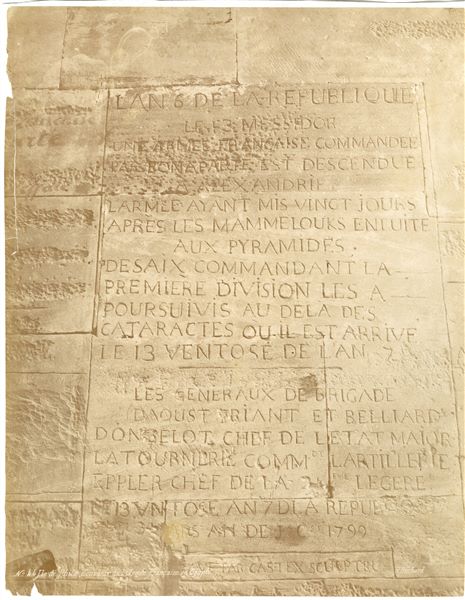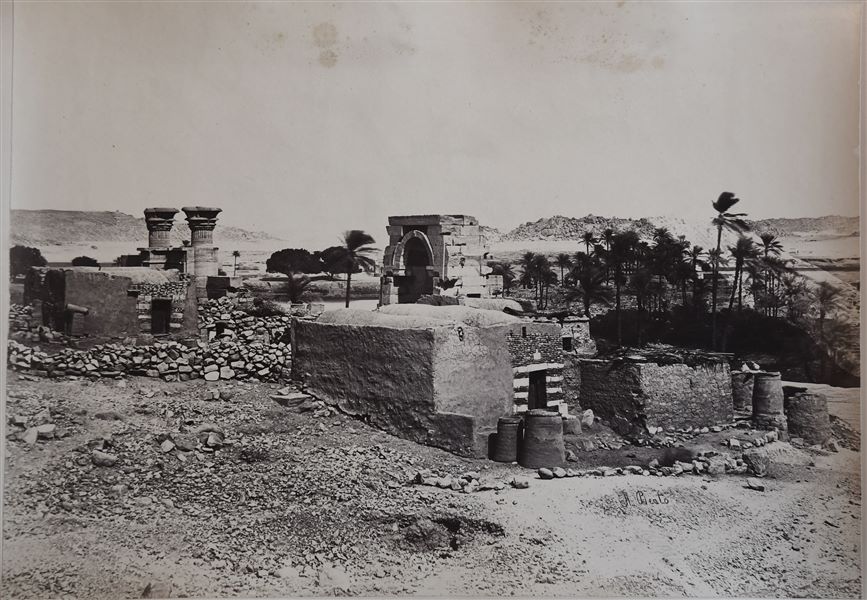The temple of File. Reproduction on a photographic plate of a nineteenth-century photograph signed by Antonio Beato.
The photograph shows a view of the island of Philae from the southwest, where the façade of the Temple of Isis and Trajan’s Kiosk, together with the large retaining structures and the west portico stand out. In the foreground, the shoreline of the island of Bigeh and the Nile, with the Upper Egyptian landscape visible in the background. The temple complex was relocated in the 1970s to the nearby Agilkia island, following the construction of the Aswan Dam and the formation of Lake Nasser, which would have submerged it. The author’s signature is at the bottom left.
The photograph shows a view of the island of Philae from the southwest, where the façade of the Temple of Isis and Trajan’s Kiosk, together with the large retaining structures and the west dromos stand out. In the foreground, the shoreline of the island of Bigeh and the Nile, with the Upper Egyptian landscape visible in the background. The temple complex was relocated in the 1970s to the nearby Agilkia island, following the construction of the Aswan Dam and the formation of Lake Nasser, which would have submerged it. The author’s signature is at the bottom left.
Overview of the Temple of Isis on the island of Philae, taken from the nearby island of Bigeh. Clearly visible are Trajan’s Kiosk (on the right) and the first pylon which provides access to the temple (in the centre).
View of the western shoreline of the island of Philae, with the various structural elements of the temple complex dedicated to the goddess Isis.
Overview of the Temple of Isis on the island of Philae, taken from the nearby island of Bigeh. The author's signature is visible at the bottom left.
View of the island of Philae with the temple complex dedicated to the goddess Isis. On the left is the Kiosk erected by Emperor Trajan.
Photograph of the temple complex of Philae seen from the Nile. On the left, Trajan’s Kiosk is clearly visible. On the right is a moored felucca. The author's signature has been placed on the left, in the reflection on the water.
View of the Temple of Isis on the island of Philae. Note the presence of numerous mud-brick constructions from later periods, which were not “saved” when the temple was moved to the Agilkia island. The author's signature has been placed (faintly visible) at the bottom right.
The photograph shows the pylon of the Temple of Isis on the island of Philae (shown in its entirety) with the colonnade on the right. The author's signature is visible at the bottom right.
The image shows an overall view of the entrance (southern side) of the temple complex dedicated to the goddess Isis on the island of Philae. The courtyard, the side colonnades and the entrance pylon are visible. In front of the pylon is a white conical tent. The author's signature can be found at the bottom right, in mirrored writing.
The image shows a view from the north-west of the temple complex of Isis on the island of Philae, photographed from the neighbouring island of Bigeh. The author's signature can be found at the bottom right.
View of the island of Philae, where there is the temple complex dedicated to the goddess Isis. In the photograph the first pylon of the temple in the centre is clearly visible (behind this, the second pylon can be glimpsed), and on the right is Trajan’s Kiosk. The author's signature is visible at the bottom left.
View of the entrance to the temple complex dedicated to the goddess Isis on the island of Philae. The courtyard with the colonnade on either side is visible, as well as the entrance to the first pylon of the temple and on the right, the Kiosk erected by the Emperor Trajan. The name of the author is clearly visible at the bottom left.
View of the western colonnade from the temple complex of Isis at Philae, in its original position, with the Kiosk of Pharaoh Nectanebo and the Nile in the background. The temple was relocated in the 1970s to the nearby Agilkia island following the construction of the Aswan Dam and the formation of Lake Nasser, which would have submerged it. The author's signature is visible at the bottom right.
The image shows a view of the long western colonnade of the temple complex of Isis at Philae seen from the south, where at the end, the Hathoric capitals of the Kiosk of Pharaoh Nectanebo I can be seen on the left. The author's signature can be found at the bottom left.
Detail of the temple complex of Isis on the island of Philae, where the portico of the Mammisi is photographed, with columns with Hathoric capitals, still partially covered by a layer of earth and sand. The Mammisi is a building constructed in the Late and Greek-Roman periods, positioned next to a major temple to celebrate the mysteries of divine births. The author's signature is at the bottom right.
View of the temple complex at Philae, where the first and second pylons are clearly visible. In front, brick remains of dwellings, no longer surviving . The photo can be attributed to Antonio Beato.
The image presents a view of the western colonnade of the Philae temple complex seen from the river (south), in its original position.
The photograph shows the colonnade of the Temple of Isis in Philae. In the centre, three egyptians pose for the photographer. Part of the entrance pylon can be seen on the right. The author's signature is at the bottom left.
The photograph shows the first pylon and the colonnaded courtyard in front of it, from the Temple of Isis on the island of Philae. Note the presence of small brick buildings from a later period, built on a surface that still covers the lower part of the ancient columns.
View of the external façade of the first pylon from the Temple of Isis at Philae.
The photograph shows the colonnaded portico of the Temple of Isis at Philae, in the first court. The ground level still covers the columns’ bases. An icorrect indication that this is the temple of Dakka has been placed at the bottom left. The author's signature is visible at the bottom right.
The photograph shows the entrance to the Mammisi of Horus (a temple dedicated to the birth of Horus, whom Isis gave birth to) located near the second pylon in the temple complex of Isis at Philae, with two egyptians staring at the camera lens. The ground still partially covers part of the elevated structure. The author's signature is visible at the bottom right.
View of the western part of the second courtyard from the Temple of Isis on the island of Philae. The second pylon is visible on the right, while on the left is the Mammisi, with the portico displaying columns with Hathoric capitals. The author's signature is at the bottom right.
View of the northern ruins of the temple complex of Isis at Philae, with mud-brick structures (no longer surviving), together with Trajan’s Kiosk in its original position, and some palm trees. The author's signature is visible at the bottom left.
Detail of the front façade, right side, from the second pylon of the Temple of Isis on the island of Philae. Pharaoh Ptolemy XII is represented making offerings to Horus and Isis. The author's signature is visible on the bottom right.
Photograph representing a side view of the temple complex of Isis at Philae. The Kiosk erected by Emperor Trajan in the 2nd century AD stands out on the left. In the foreground, the Nile with two feluccas moored near the small island. The author's signature is on the left.
View of Trajan's Kiosk on the island of Philae. On the right, some feluccas are moored on the shore of the island. The author's signature is faintly visible on the left, among the gravel.
Photograph of Trajan's Kiosk in Philae in its original location, and the eastern shore of the island, with buildings, palm groves and a moored boat.
The picture shows Trajan's Kiosk (north and west sides), still in its original position, and some Coptic mud-brick structures no longer visible after the temple was moved and rebuilt on the Agilkia island. On the left, a pylon from the temple of Isis is can be seen. The temple was relocated in the 1970s to the nearby island of Agilkia, following the construction of the Aswan Dam and the formation of Lake Nasser, which would have submerged it.
View of Emperor Trajan's Kiosk, erected near the temple complex of Isis on the island of Philae. The author's signature can be seen at the bottom.
Trajan’s Kiosk, built at the behest of the emperor on the island of Philae, in the temple complex to honour the goddess Isis. The author's signature is faintly visible at the bottom left.
Side view (northern side) of the Kiosk of Emperor Trajan, erected near the temple complex of Isis on the island of Philae. The author's signature has almost disappeared, but can be faintly seen at the bottom right, written in white on a light background.
The photograph depicts the Kiosk erected by Emperor Trajan, seen from the north, rising among the vegetation of the banks of the Nile. In the background on the right, the ruins of the temple complex dedicated to the goddess Isis on the island of Philae. The author's signature is visible at the bottom right.
Interior of the Temple of Isis at Philae. On the back wall is a graffito written in Italian, which reads “GREGORIO XVI F.R. PEGLI AUSPICI DEGLI EMINENTISSIMI PP. GAMBERINI E TOSTI FIN QUI LA SPEDIZIONE ROMANA SUL BORDO LA FEDELTA’ [CHE DAL TEVERE A] QUESTI SCOGLI [IL 21 GENNAIO 1841 APPRODAVA]”. English translation: “GREGORY XVI F.R. UNDER THE AUSPICES OF THE MOST EMINENT PP. GAMBERINI AND TOSTI SO FAR THE ROMAN EXPEDITION ON BOARD THE FAITHFUL [WHICH FROM THE TIBER TO] THESE ROCKS [ON 21 JANUARY 1841 LANDED]”.
The image shows the epigraph left by Napoleon’s army on the walls of the Temple of Isis in Philae in 1799, when they reached the island. The author's signature is visible at the bottom right.
The remains of a temple, with two columns and a doorway, formerly erected on the island of Bigeh, a small island near that of the island of Philae. Among the remains of the temple, mud-brick structures from modern times are visible. Today, the small island is partially submerged by Lake Nasser.
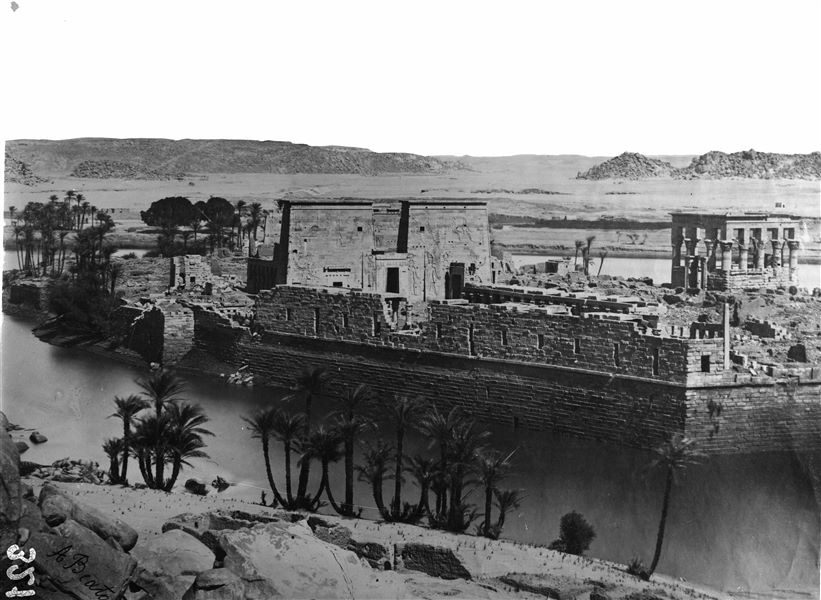
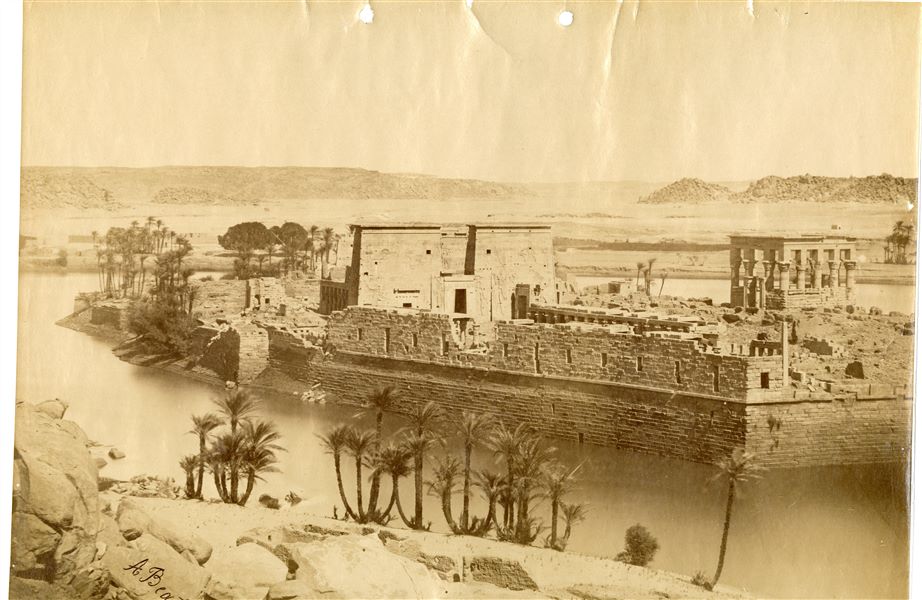
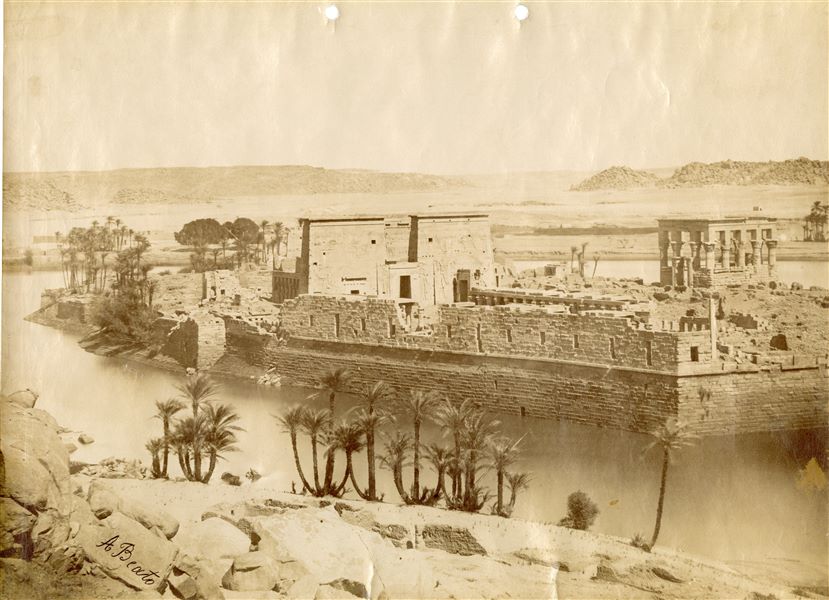
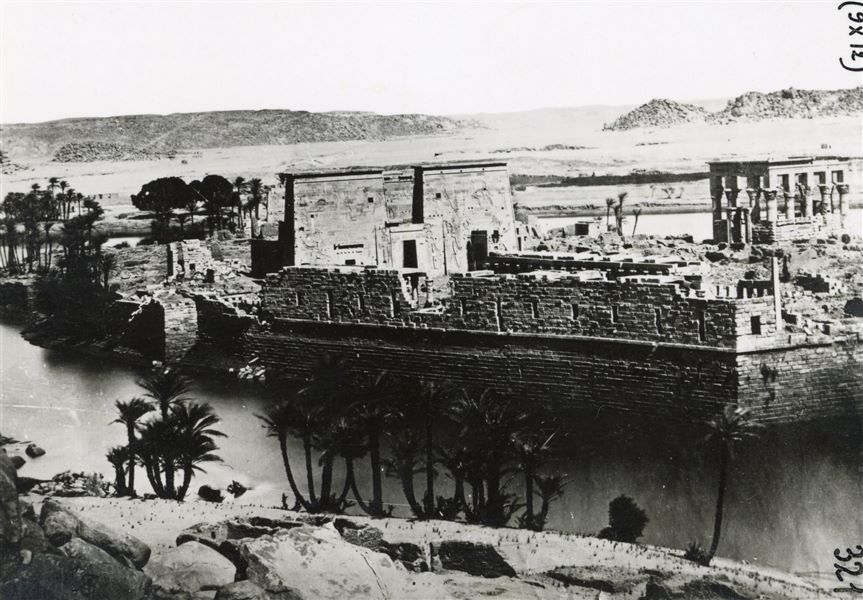

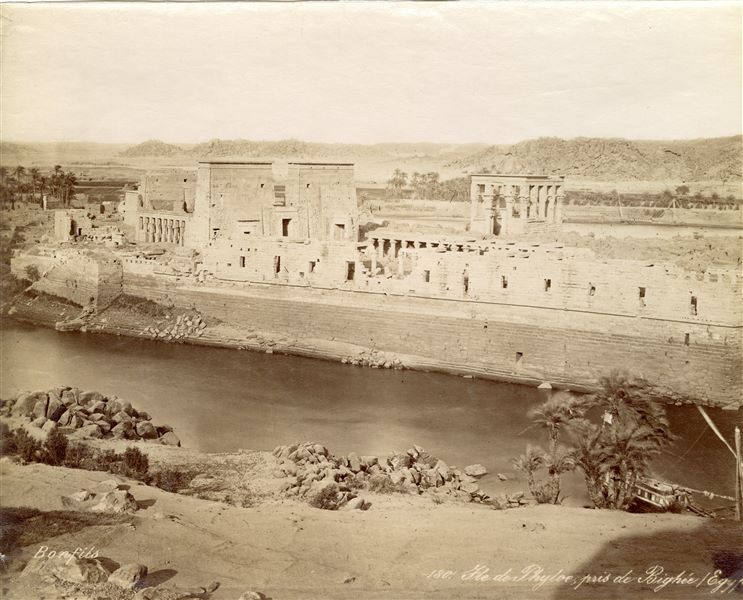

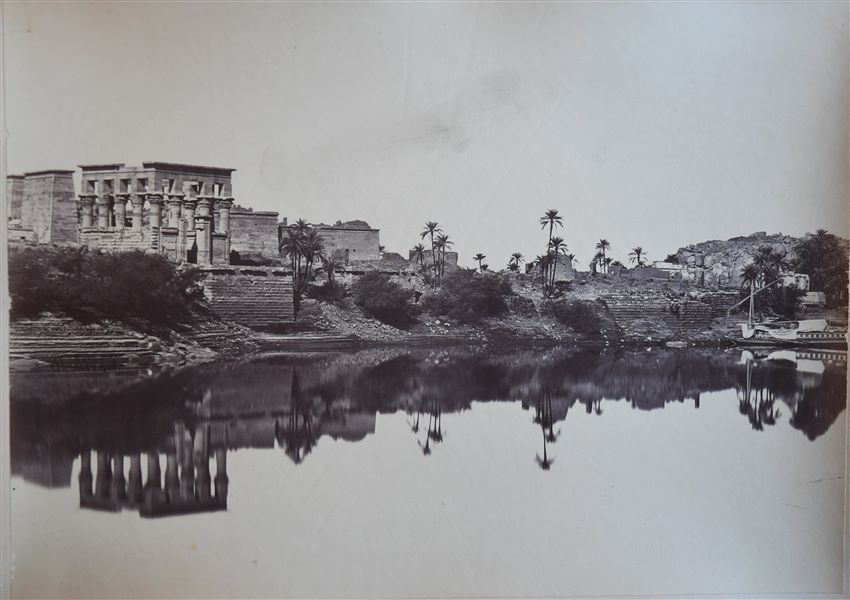
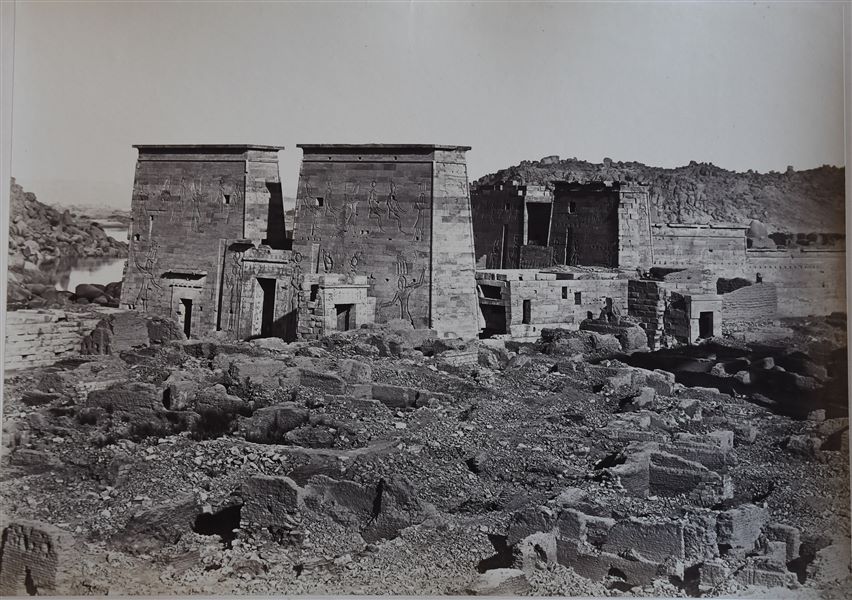
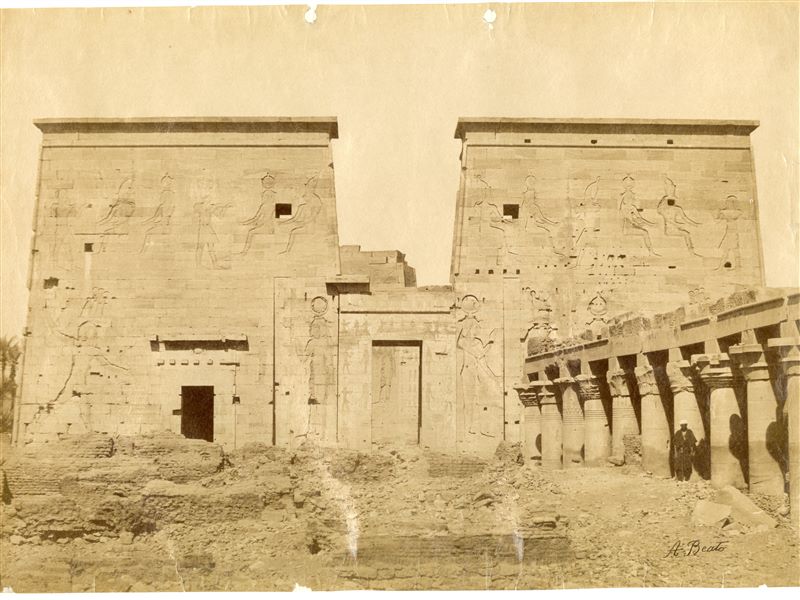

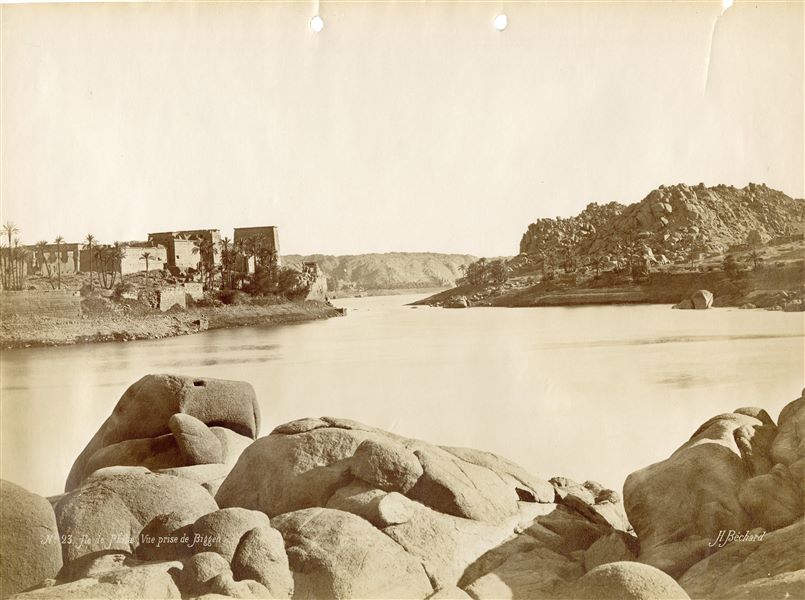

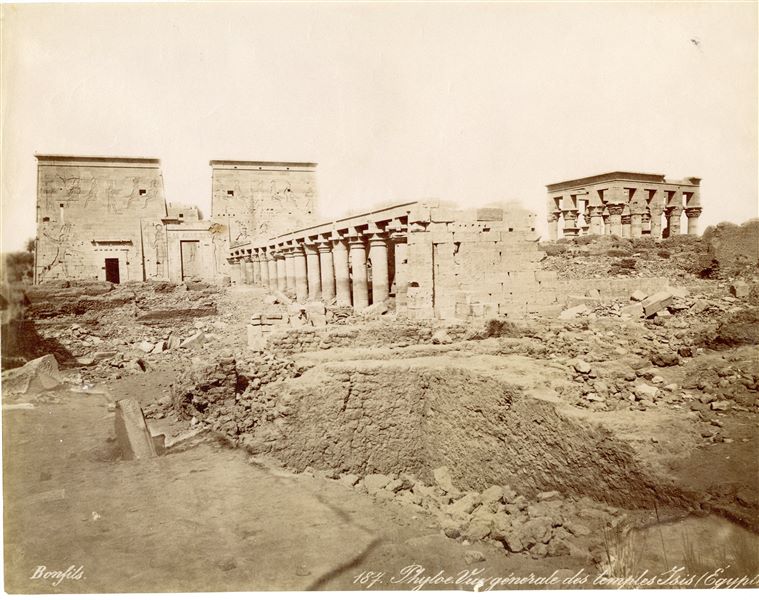
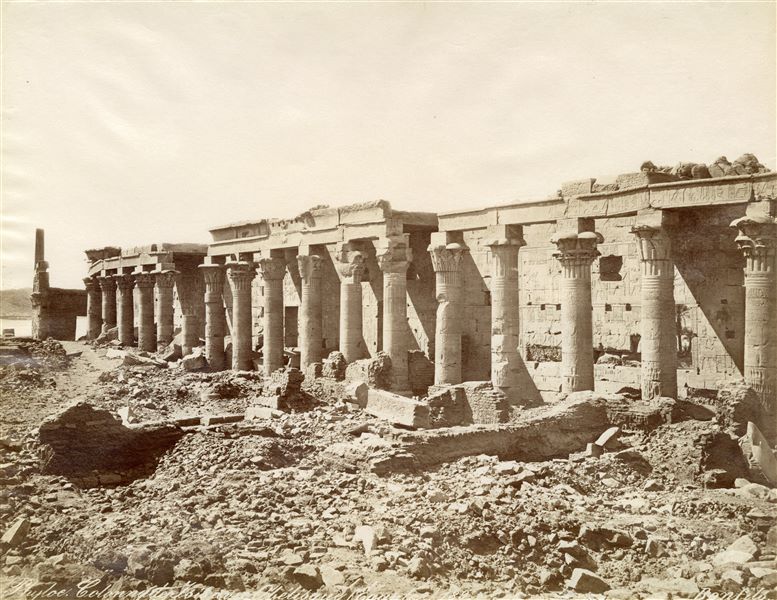
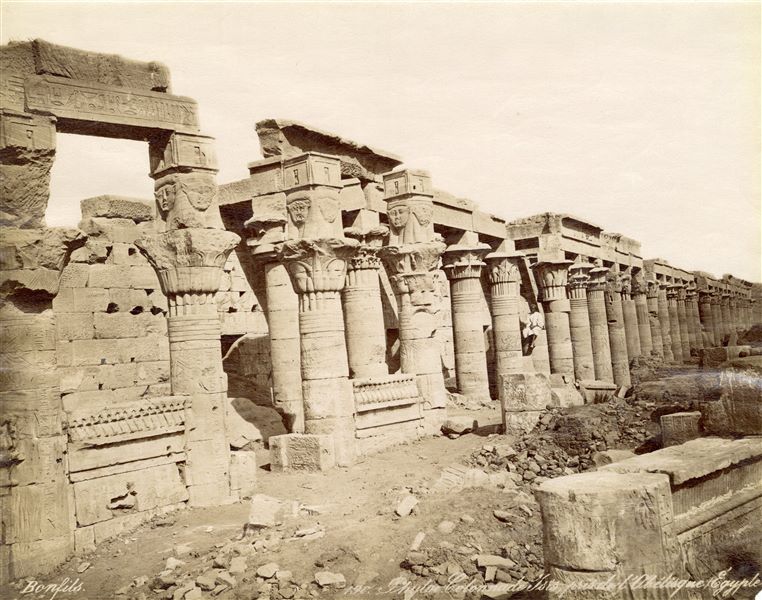
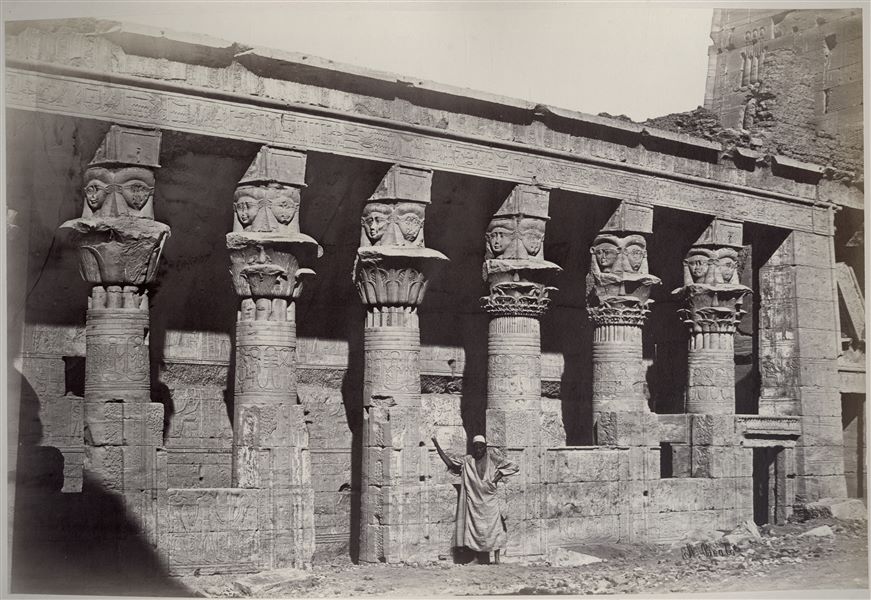

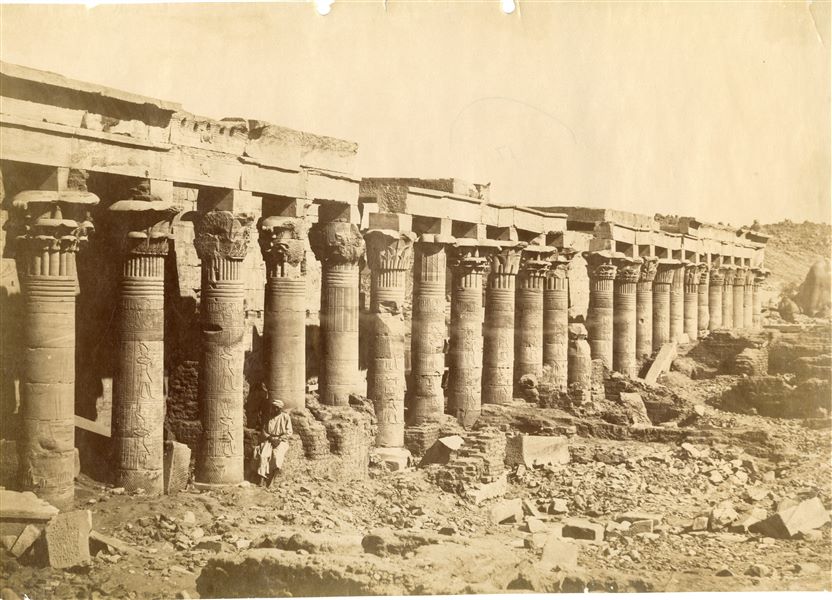
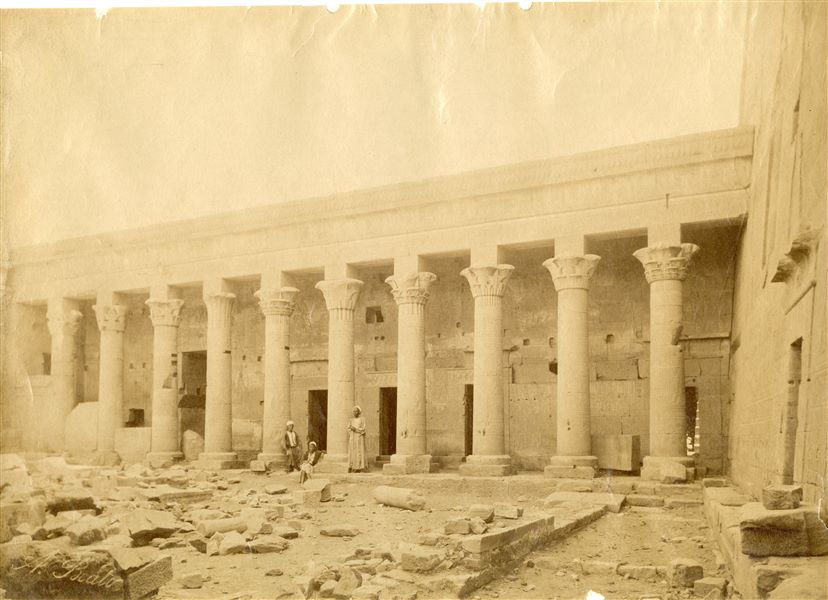

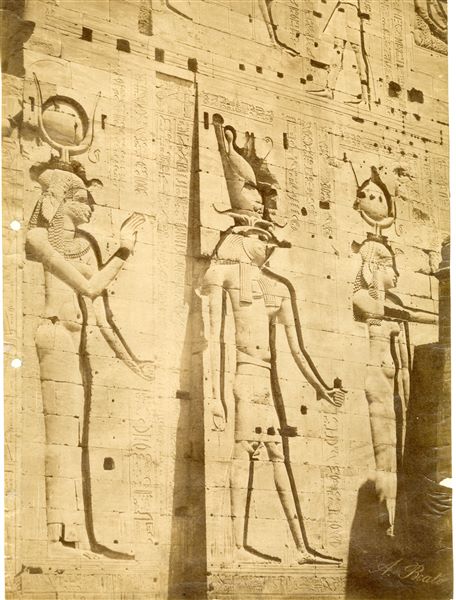



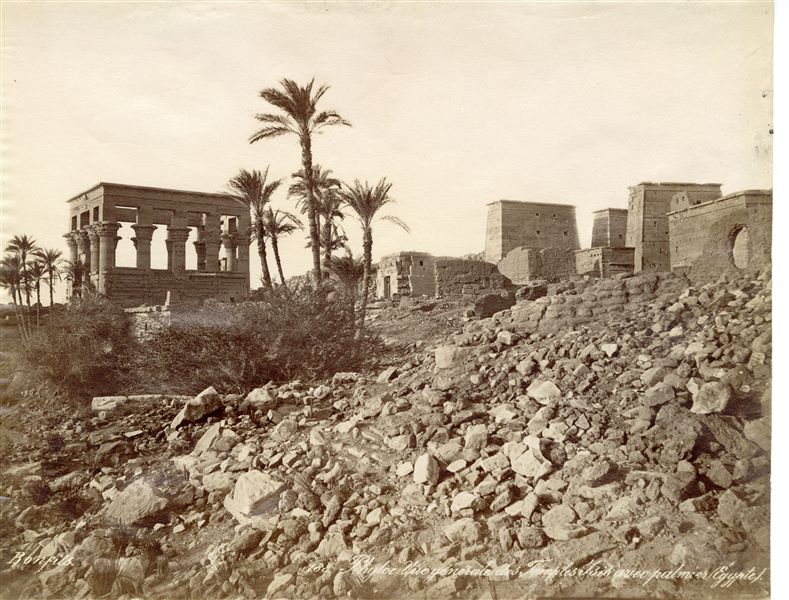



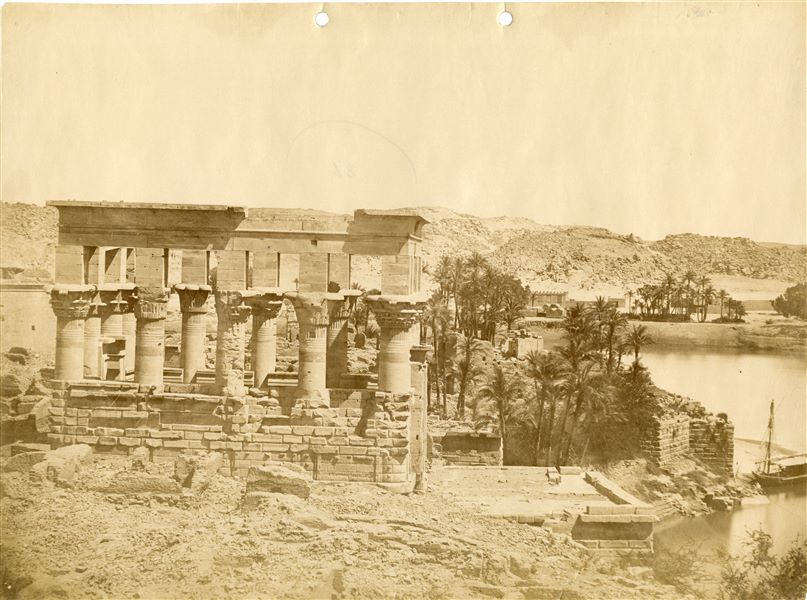
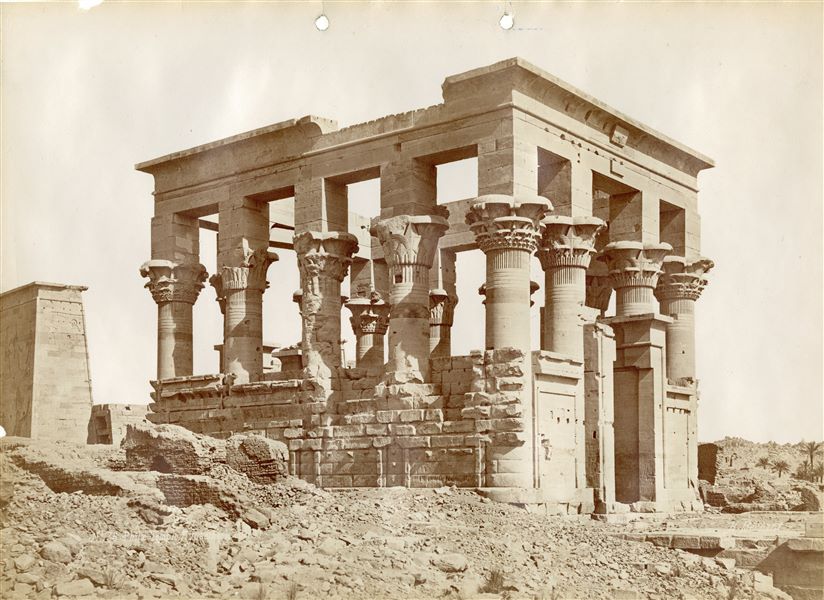
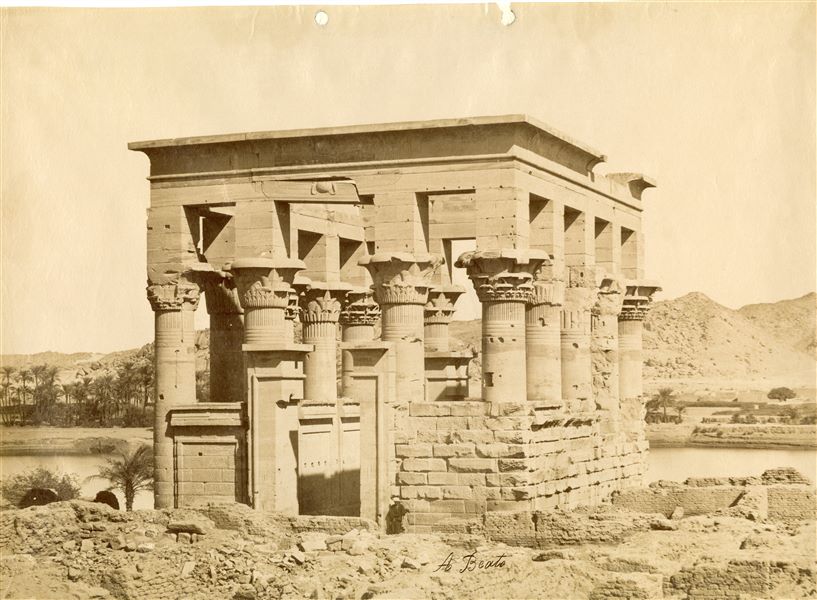

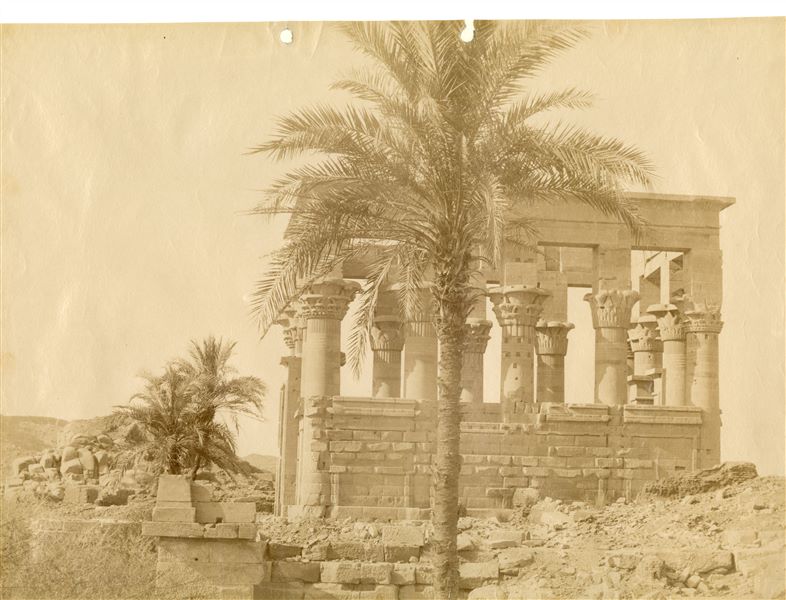
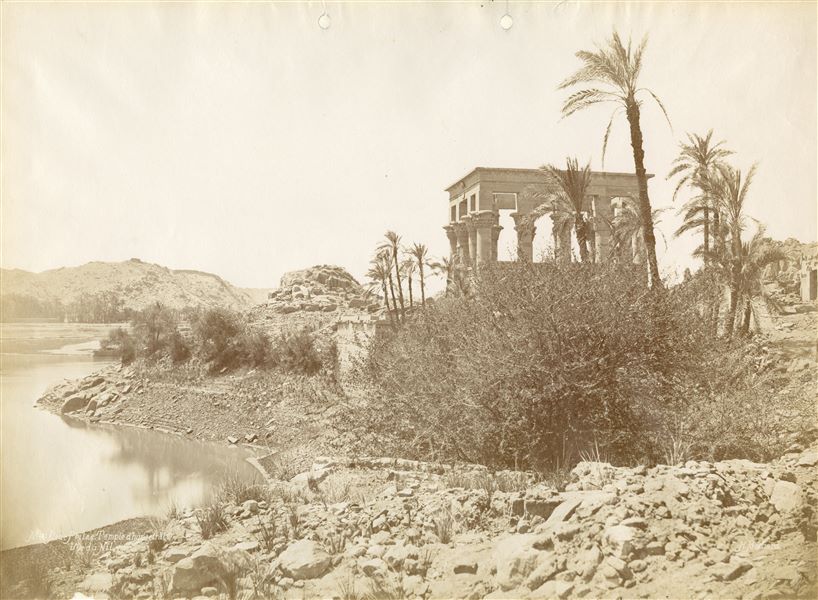
![Interior of the Temple of Isis at Philae. On the back wall is a graffito written in Italian, which reads “GREGORIO XVI F.R. PEGLI AUSPICI DEGLI EMINENTISSIMI PP. GAMBERINI E TOSTI FIN QUI LA SPEDIZIONE ROMANA SUL BORDO LA FEDELTA’ [CHE DAL TEVERE A] QUESTI SCOGLI [IL 21 GENNAIO 1841 APPRODAVA]”. English translation: “GREGORY XVI F.R. UNDER THE AUSPICES OF THE MOST EMINENT PP. GAMBERINI AND TOSTI SO FAR THE ROMAN EXPEDITION ON BOARD THE FAITHFUL [WHICH FROM THE TIBER TO] THESE ROCKS [ON 21 JANUARY 1841 LANDED]”.](https://archiviofotografico.museoegizio.it/data/media/STORICO/15-assuan/tempio-di-file/fotografie-ottocentesche/F0753E6E7B231566C236711E17668D32.std_big.jpg)
